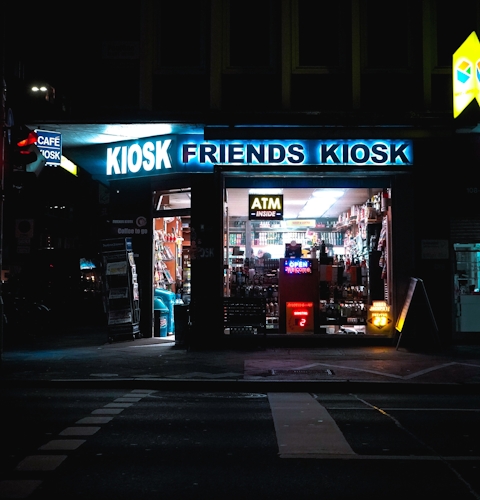
Celebration of the Späti: A Berlin Institution
03/2022 - Sahar Saini
"Love at first sight" is the most accurate phrase to define my first acquaintance with the Späti culture. My friend, with whom I was meeting for drinks on a Saturday night, gave me an address and told me it was going to be our first stop. As I approached my first späti ever, my expectations for the night immediately dropped. I know now I’d never been more wrong.
A few minutes later, my friend showed up and there began my introduction to the world of Berlin Spätis. At first, I thought it was a convenient place for a pre-club drink, offering a 1.50 euro Berliner Pilsner on one of those wooden benches. However, my friend didn’t choose just an ordinary späti for my first experience. This Späti had it all—the crowd, a waiting line, disco lights, and the owner could’ve doubled as a DJ playing tunes ranging from hip-hop to techno. Within minutes, we’d struck up a conversation with our neighbours, and were joined by whoever could squeeze their butts onto that single wooden bench. Our mixed crew of späti beer drinkers ended up spending hours on those benches, trading life philosophies. It was then that I understood that forging new friendships over cheap beers outside of the Späti was, indeed, a quintessential Berlin experience.
The idea for the late-night shops originated in East Germany, initially to meet the needs of many shift workers who couldn’t buy groceries during regular store hours. The early version of today’s beloved Spätis was meant to be a symbol of how progressive the state was. If you’ve been to Berlin, you’re probably already familiar with one of the city’s most well-known and beloved institutions: the Späti. If you haven’t, the Spätkauf will come as a pleasant surprise, for it is what makes Berlin—Berlin. In no time, Spätis made friends from all over the world, drawing in locals, tourists, and expats alike. I heard someone on the street say—“It’s a meeting point where all walks of life collide.”
When the Wall came down in 1989, these little shops quickly exploded in both the East and West. The Späti has over 900 cousins today. I’ve had one close to wherever I’ve lived in Berlin. These gems are everywhere and some people are blessed to have one next to them that’s open 24/7. They look similar, there are a few exceptions like the disco/hip-hop/techno Späti I spoke of at the beginning. Fridges full of drinks, alcoholic and non-alcoholic. Behind the cashier, everything from gum to cigarettes and rolling papers. The shelves overflowing with basic necessities ranging from chocolate bars, fruits, cereals, dry goods, condoms, shampoos. The joy of finding these necessities in a Späti on a Sunday when the grocery stores are closed remains unmatched.
For many including myself, the Späti is considered to be an essential Berlin institution. And, why shouldn’t it be? These corner stores are so loved by residents that Berliners have been fighting for years against the rule that stores must remain closed on Sundays in an effort to keep their local convenience shop open. They’re now included in travel guidebooks and entire books have been written about them. There’s street art dedicated to them and bloggers like myself who write about them with unequalled passion.
When you visit Berlin, you can go on a Späti crawl and join strangers as you drink and merry your way from shop to shop. Often, when you visit you can see locals sharing the familiar details of their lives with the regular shopkeeper. Most importantly, the Späti has become a contact point for people within the anonymity of a capital city. They open up spaces for strangers to learn about each other and, in some cases, forge a deeper connection and lasting friendships. Perhaps, that’s the reason for the jovial faces—young and old, you get to see during summer evenings.














